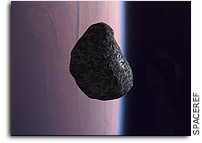Asteroid fragments on a fast collision course with Earth

ETH researchers determined travel times of asteroid fragments
Over a million large asteroids, each several kilometres wide, are orbiting the Sun in a belt between Mars and Jupiter. There are sometimes violent collisions. Until now, it has been thought that the resulting asteroid fragments would need several million years to reach the Earth. New measurements from the Noble Gas Laboratory of ETH Zurich show however, that the Earth could be reached much sooner. This knowledge is significant for the prediction of future meteorite impacts on Earth.
Collisions in the Asteroid Belt result in the asteroids being completely destroyed and shattered into countless pieces. Computer simulations predict that most of these fragments will eventually fall into the Sun. Some of them, however, will hit the Earth after millions of years as meteorites. It is possible that this could also occur much earlier. In certain positions in the Asteroid Belt, the orbiting time of an object around the sun is a multiple of the orbit of the giant planet Jupiter. The so-called orbital resonance can lead to a disruption in the object’s orbit. It can change the orbit so much that the object would cross the Earth’s orbit and collide with the Earth. Up until today, when this might occur has only been theoretically calculated. But, a new measurement method developed by a research team at the Institute for Isotope Geology at ETH Zurich can now bring more certainty to the subject. The team has established that it could take just a few hun-dred thousand years for such an object to collide with our planet.
Concentrations of noble gases tell the travel time of an asteroid
Collisional fragments from asteroids in space are constantly being hit by cosmic radiation. This creates noble gases from nuclear reactions. These gases do not enter into any further chemical reactions. Therefore, during the entire duration of the radiation, i.e., the travel time of the fragment in space, they accumulate in the fragment. After measuring the concentration of these so-called cosmogenic inert gases, the travel time from original body to Earth can be calculated. The higher the concentration, the longer the meteorite was underway.
Fossil meteorites: participants in a catastrophe
The researchers used meteorites for their tests that are assumed to be the re-sults of a huge asteroid collision in the recent history of the solar system. These meteorites were found in a stone quarry in southern Sweden in a 480 million year old seabed deposit. What is astonishing is that the fragments still show the traces of the inert gases absorbed more than 500 million years ago.
“Tom Dooley” allows measurement of very small amounts of gas
The Noble Gas Laboratory at ETH Zurich has a highly sensitive mass spectrometer, nicknamed “Tom Dooley”, that is specialized for the measurement of extremely small amounts of gas. This instrument, developed at ETH, condenses the test gas into a tiny volume in order to raise the concentration to the point that even rare gases, such as the helium or neon in a single dust particle, can be measured. The sensitivity of this instrument is more than a hundred times higher than conventional mass spectrometers. The device is unique, world wide. Using this instrument, the young researcher Philipp Reza Heck found a method for measuring a very small amount of cosmic inert gas. To do this, just a few micrograms of lightweight meteorite sample is melted with an infrared laser and the gas is then set free and cleaned. Heck then measures the isotopes of the elements helium and neon with “Tom Dooley” spectrometer.
Confirmation of the shorter travel time
With the new method, it could be proven for the first time that the noble gases in the meteorites in southern Sweden were already in the meteorites 480 million years ago. The calculated travel time was reduced to a few hundred thousand years, which corresponds to the lower limits predicted by the computer simulations. These were the first fragments to arrive on Earth after a great collision. The short radiation age is a clue that the collision took place in the proximity of an orbital resonance in the Asteroid Belt. In addition, it could be proven that the fossil meteorites from southern Sweden all stem from the same event. The newly developed method from the Institute for Isotope Geology makes it possible to confirm the theories about the behaviour of asteroid fragments in space. This will make it significantly easier for researchers to predict future collisions with our planet.
Kontakt
Philipp Reza Heck
Institute for Isotope Geology
Department of Earth Sciences
Tel. +41 1 632 79 72
Prof. Rainer Wieler
Institute for Isotope Geology
Department of Earth Sciences
Tel. +41 1 632 37 32









